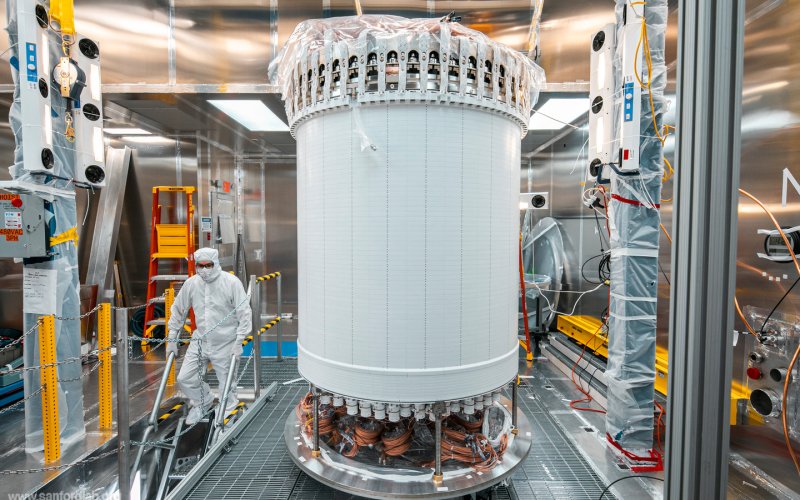‘Nowhere Near Done’ — UAlbany Physicists Hail Latest in Dark Matter Hunt

ALBANY, N.Y. (Aug. 26, 2024) — Physicists at the University at Albany on Monday hailed the latest progress in the hunt for direct evidence of dark matter — believed to be a massive-but-so-far-invisible building block to the universe — as the newest results from the LUX-ZEPLIN project were unveiled at two scientific conferences.
LUX-ZEPLIN, or LZ, is the most sensitive dark matter detector in the world, and its operation is a collaboration among scores of international scientists from 38 institutions, including Associate Professor Cecilia Levy and Associate Professor Matthew Szydagis in UAlbany’s Department of Physics.
LZ, led by the Department of Energy’s Lawrence Berkeley National Laboratory, hunts for dark matter from a cavern nearly one mile underground at the Sanford Underground Research Facility in South Dakota.
The LZ experiment is attempting to detect dark matter by measuring the light and other signals emitted by its collision with other particles—specifically 10 tons of liquid xenon. While LZ has not yet directly detected dark matter, the significance of the latest results is that they help the scientists narrow down the search.
One of the Greatest Puzzles in Physics
"Dark matter interacts very, very rarely with normal matter, but we don’t know exactly how rarely," Levy said. "The way we measure it is through this cross section, or how probable an interaction is within our detector. Depending on the mass of a dark matter particle, which we don't know yet, an interaction within the detector is more or less probable. What the new LZ results tell us is that dark matter interacts with normal matter even more rarely than we thought, and the only instrument in the world that is sensitive enough to measure that is LZ."
Figuring out the nature of dark matter, the invisible substance that makes up most of the mass in our universe, is one of the greatest puzzles in physics. New results from LZ have narrowed down possibilities for one of the leading dark matter candidates: weakly interacting massive particles, or WIMPs.
“It's often misunderstood what is meant by the phrase 'world's best dark matter experiment,' since no one has made a conclusive, unambiguous discovery yet,” Szydagis said. “However, new, stricter null results like LZ's are still extremely valuable for science. UAlbany, as one part of the multinational collaboration that is LZ, has been making important contributions ensuring the robustness of LZ's results, going back to the very beginning of the experiment."
The current UAlbany LZ team also includes postdoctoral researcher Meghna Kannichankandy and PhD students Greg Blockinger and Abantika Ghosh. Previous members of the LZ Albany group include Alvine Kamaha, Greg Rischbieter and Nishat Parveen. The team at UAlbany has over the years been involved in various crucial aspects of the experiment such as assembly, calibrations, simulations and data analysis.
‘If it were easy, someone would have done it already’
Unseen, because it does not emit, absorb or scatter light, dark matter’s presence and gravitational pull are nonetheless fundamental to our understanding of the universe. For example, the presence of dark matter, estimated to be about 85 percent of the total mass of the universe, shapes the form and movement of galaxies, and it is invoked by researchers to explain what is known about the large-scale structure and expansion of the universe.
Levy noted UAlbany scientists have been making integral contributions to LZ for more than a decade.
“Working on LZ is always so exciting, even if we still have not made a discovery yet,” Levy said. “We all know that if it were easy, someone else would have done it already! I think right now what we need to take out of this result is that LZ is a great team of scientists, our detector is working superbly, our analysis is extremely robust and we are nowhere near done taking data.”





